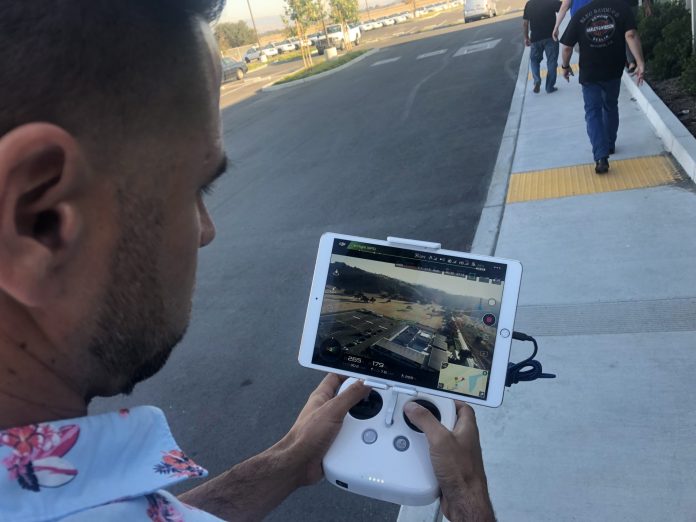When 21-year-old Gavilan College student Brandon Puthoff learned about the new drone program being offered at the Coyote Valley campus north of Morgan Hill, he jumped on the opportunity right away and signed up for several classes in the six-course certificate program.
“I’m hoping to make a career out of it,” said Puthoff, of Morgan Hill, who is currently enrolled in the advanced aerial photography class after completing the introductory course last semester. “The most important thing is the classes are being taught by people who are professionals in the field.”
In the same Oct. 19 class held at Gavilan’s Bailey Avenue site, 55-year-old San Jose resident Larry Gonzales was looking to parlay his previous career in software development into a new venture in the drone industry by completing the certificate program.

“I’m in the process of switching careers and wanted to learn more about this industry,” said Gonzales, who holds a bachelor’s degree in biology from San Jose State University.
He started with two introductory classes and is now taking advanced aerial photography and a second in drone maintenance. Next semester, Gonzales—who had been flying drones recreationally for about five years prior—plans to take two more drone classes: Federal Aviation Administration rules and regulations as well as Sensors and Payloads.
“It’s been well worthwhile,” he said. “I’ve been refocusing what I wanted to do career-wise, and this was a natural segue into the industry.”
Instructor Mike Bonillas teaches the Gavilan drone program classes and runs his own “drone solutions” business called Brilliant Perspective with longtime friend, fellow instructor and business partner Anthony Olson.
“We started our business four years ago as a drone photography company and realized right away that the drone industry was going to take off and became a drone solutions company,” Bonillas said. The certified drone pilot and flight instructor also teaches an after-school introductory drone class at Live Oak High School through Gavilan’s Career Technical Education program.
“The biggest thing that people can take away is that the drone is a tool and they can add it to their repertoire of something they already do,” Bonillas added. “If they are a real estate agent or an insurance agent, a sports coach or a teacher, a biologist or somebody that does geography, search and rescue—anybody who does any stuff with the environment—it can be huge.”
The possibilities are endless, and Bonillas wants to help nurture that in any person who registers for his classes at Gavilan, where about 35 students are currently enrolled in any of the six classes that allow them to pilot drones above the scenic hills on the 55 acres of community college land. Classes, which are part of Gavilan’s Aviation Technology Department, last anywhere from three to five hours and include lecture and lab.
“This is a drone pilot’s paradise,” said Bonillas, looking around the Coyote Valley campus. “You get the sunset off the hills. We’re in a small bubble away from all air space. It’s an opportunity for people to just come out and fly all types of drones.”

Gavilan, which supplies the drones to its students, is one of only a handful of colleges in the state that is certified through the State Chancellor’s Office to issue a drone operator’s certificate, and those units are all transferable, Bonillas said. The program is in its third semester.
“We will teach you everything you need to do to be a successful drone pilot,” Bonillas added. “You learn basic maneuvers and how to operate and just move on from there to aerial photography, advanced aerial photography, FAA rules and regulations, repair and maintenance, and sensors and payloads.”
Puthoff said what drew him to drones and the Gavilan pathway “was seeing everything from a different perspective” from high above.
“Drones are the future for many different industries,” said Puthoff, who also has his FAA certification.
Gonzales is in his second semester with the drone program, taking two classes each term.
“They have just really given me insight into what I might want to do and where I can use my skills in the drone industry,” said Gonzales. “It’s just a new perspective from up in the air. That’s what kind of led me into this. If someone is curious about it, they should come out and learn what it’s about.”
To get Friday’s class started, Bonillas had his students create a new online drone deploy profile (which can be done on sites such as 360hangar and Pix4D) and map out their flight plans for the day. After charging the drones, the students headed outside to take flight.
“It gives you a completely different viewpoint of what you’ve ever looked at before,” Bonillas said. “Here at Gavilan we have about 35 people, ages 18 to 60 and every single one of them has a different idea of what they want to do.”
MORE INFO
To learn more about the drone program at Gavilan College, visit gavilan.edu/academic/aviation/Drone%20Technology.php.
Two Options for Flying Your Drone Legally
According to Federal Aviation Administration
Fly under the Special Rule for Model Aircraft
(Section 336)
•Fly for hobby or recreation only
•Register your model aircraft
•Follow community-based safety guidelines and fly within the programming of a nationwide community-based organization
•Fly a model aircraft under 55 pounds unless certified by a community-based organization
•Fly within visual line-of-sight
•Never fly near other aircraft
•Notify the airport and air traffic control tower prior to flying within five miles of an airport
•Never fly near emergency response efforts
Fly under the FAA’s Small UAS Rule
(Part 107)
•Fly for recreational or commercial use
•Register your drone
•Get a Remote Pilot Certificate from the FAA
•Fly a drone under 55 lbs.
•Fly within visual line-of-sight*
•Don’t fly near other aircraft or over people*
•Don’t fly in controlled airspace near airports without FAA permission*
•Fly only during daylight or civil twilight, at or below 400 feet*
*These rules are subject to waiver.













